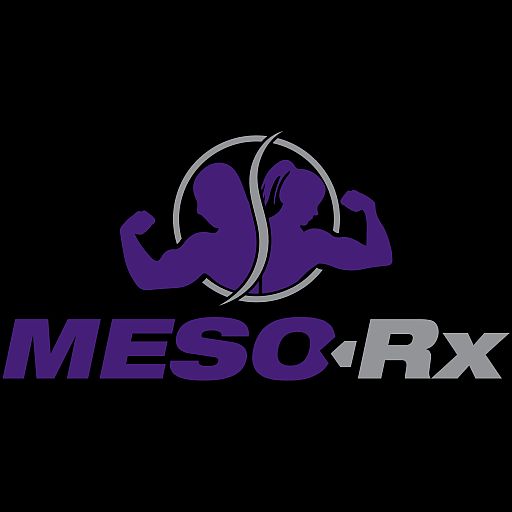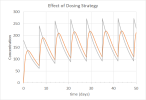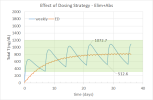Type-IIx
Member
The matter of testosterone base (as aqueous, water-based; or in oil vehicle, as Testosterone No Ester [TNE]) and changes to estradiol (E2) is one of much confusion.
In fact, before the availability of AI & SERM drugs, besides compound selection strategies aimed at moderate testosterone dosing & rational combination strategies (e.g., synergistic [1 + 1 > 2], complementary [1 + -1 = 0], & additive [1 + 1 = 2]) and tactics (e.g., manipulating administration schedules/frequencies to optimize efficacy/tolerability tradeoffs), the use of testosterone suspension during contest prep & even peak week where anabolics were maintained right up to the contest was a commonplace strategy to reduce fluid retention.
See Robert Kerr's 1982 book, "The Practical Use of Anabolic Steroids with Athletes..." Chapter 12:
Indeed, bloodwork evidence supporting this rational use exists in the annals of this very forum. From Testosterone No Ester (TNE) PART 2...
At 2.5 - 3 h post-injection (50 mg testosterone base, oil vehicle; TNE)...Cmax (peak concentration) occurring between 1 - 2 h for most individuals:
Noteworthy Results: insignificant rise in estradiol (E2: 22.6 vs. 20.1 [base-line] pg/mL; no significant increase to HCT, Hb; LH & FSH remained normal).
Edited & Summarized by Type-IIx, for clarity, a statement relayed by the post author from a private medical consultant, explaining that:
1. Erythropoiesis: Erythrocyte (RBC; red blood cell) formation takes 7 days, so injecting a rapid source of testosterone would not cause the body to create as many RBCs as a longer ester testosterone formulation, such that the body would clear the single dose (TNE; 50 mg) before a full account of the production of RBC would occur, thereby maintaining normal RBC #, on short (< 1 w) time-frames & wide administration intervals.
2. Pharmacokinetics vs. Pharmacodynamics: Although the body does compensate for the increased level of testosterone, it's a longer process then the peak of the half life testosterone itself, and the rise in estrogen is more of an after-effect than something that will be perfectly coupled to by testosterone dose. Daily injections of TNE will superimpose estradiol elevations dose- & time- dependently; indeed, injecting as frequently as q9d (every nine days) may lead to superimposition (from the Tlast [max] PK data for aqueous testosterone suspension).
Further Reading from Type-IIx's Notes:
Andronaq; Sterotate; Virosterone (aqueous)
Pharmacokinetics
Biphasic delivery profile:
References
[64] SEVRINGHAUS, E. L., & SIKKEMA, S. (1946). THERAPY WITH AQUEOUS SUSPENSIONS OF TESTOSTERONE. The Journal of Clinical Endocrinology & Metabolism, 6(6), 415–419. doi:10.1210/jcem-6-6-415
[65] MOELLER, B. C., SAMS, R. A., GUINJAB-CAG, MAT, J., SZABO, N. J., COLAHAN, P., & STANLEY, S. D. (2011). An interlaboratory study of the pharmacokinetics of testosterone following intramuscular administration to Thoroughbred horses. Journal of Veterinary Pharmacology and Therapeutics, 34(6), 588–593. doi:10.1111/j.1365-2885.2011.01277.x
In fact, before the availability of AI & SERM drugs, besides compound selection strategies aimed at moderate testosterone dosing & rational combination strategies (e.g., synergistic [1 + 1 > 2], complementary [1 + -1 = 0], & additive [1 + 1 = 2]) and tactics (e.g., manipulating administration schedules/frequencies to optimize efficacy/tolerability tradeoffs), the use of testosterone suspension during contest prep & even peak week where anabolics were maintained right up to the contest was a commonplace strategy to reduce fluid retention.
See Robert Kerr's 1982 book, "The Practical Use of Anabolic Steroids with Athletes..." Chapter 12:
If "making weight"... the aqueous testosterone... might be considered... Daily or every other day injections are used with no gain in the fluid weight. No one enjoys being injected on a daily basis so this medication is limited to the last week, two at most. As the solution is water-based, a very small caliber hypodermic needle...pain-free. If the daily injections are desired and recommended to the patient, I would probably recommend 100 to 200 mg. per day of the aqueous testosterone solution...
Indeed, bloodwork evidence supporting this rational use exists in the annals of this very forum. From Testosterone No Ester (TNE) PART 2...
At 2.5 - 3 h post-injection (50 mg testosterone base, oil vehicle; TNE)...Cmax (peak concentration) occurring between 1 - 2 h for most individuals:
Noteworthy Results: insignificant rise in estradiol (E2: 22.6 vs. 20.1 [base-line] pg/mL; no significant increase to HCT, Hb; LH & FSH remained normal).
Edited & Summarized by Type-IIx, for clarity, a statement relayed by the post author from a private medical consultant, explaining that:
1. Erythropoiesis: Erythrocyte (RBC; red blood cell) formation takes 7 days, so injecting a rapid source of testosterone would not cause the body to create as many RBCs as a longer ester testosterone formulation, such that the body would clear the single dose (TNE; 50 mg) before a full account of the production of RBC would occur, thereby maintaining normal RBC #, on short (< 1 w) time-frames & wide administration intervals.
2. Pharmacokinetics vs. Pharmacodynamics: Although the body does compensate for the increased level of testosterone, it's a longer process then the peak of the half life testosterone itself, and the rise in estrogen is more of an after-effect than something that will be perfectly coupled to by testosterone dose. Daily injections of TNE will superimpose estradiol elevations dose- & time- dependently; indeed, injecting as frequently as q9d (every nine days) may lead to superimposition (from the Tlast [max] PK data for aqueous testosterone suspension).
Further Reading from Type-IIx's Notes:
Andronaq; Sterotate; Virosterone (aqueous)
Pharmacokinetics
An aqueous suspension of testosterone crystals injected intramuscularly in doses of 20 mg. provides a satisfactory replacement therapy in male hypogonadism. The apparent period of effective supply of testosterone from each injection is from four to seven days. [64].
Biphasic delivery profile:
The early peak concentration of testosterone is attributed to absorption of testosterone in solution from the formulation after IM administration. The second and subsequent peaks are attributed to dissolution of testosterone from the solid material in the suspension with similar results being reported in humans (Misra, et al., 1997). [65].
0.15 mg/kg aqueous testosterone suspension (75 mg/mL) in horses; mean weight 534.1 kg (i.e., mean dose 80 mg)
t1/2 (half life): median 33.0 hr (39 hr terminal), min 16.3 hr, max 56.8 hr
Tmax: median 6.0 hr, min 1.0 hr, max 408 hr (appearing between 1 - 2 hr for most horses)
Cmax: median 646 pg/mL, min 302 pg/mL, max 1308 pg/mL
Tlast: median 336 hr, min 216 hr, max 672 hr
[65]
References
[64] SEVRINGHAUS, E. L., & SIKKEMA, S. (1946). THERAPY WITH AQUEOUS SUSPENSIONS OF TESTOSTERONE. The Journal of Clinical Endocrinology & Metabolism, 6(6), 415–419. doi:10.1210/jcem-6-6-415
[65] MOELLER, B. C., SAMS, R. A., GUINJAB-CAG, MAT, J., SZABO, N. J., COLAHAN, P., & STANLEY, S. D. (2011). An interlaboratory study of the pharmacokinetics of testosterone following intramuscular administration to Thoroughbred horses. Journal of Veterinary Pharmacology and Therapeutics, 34(6), 588–593. doi:10.1111/j.1365-2885.2011.01277.x








